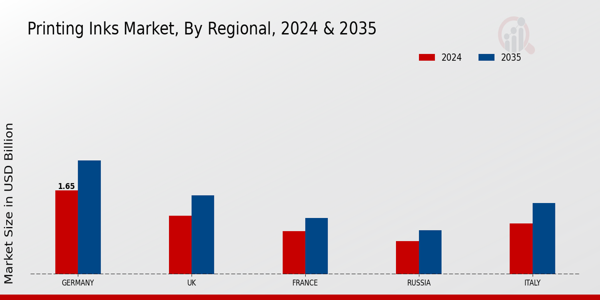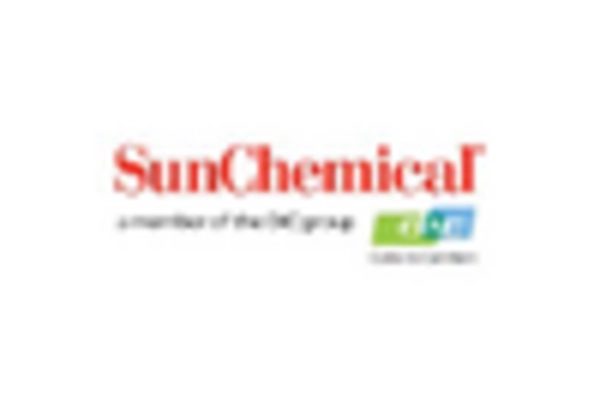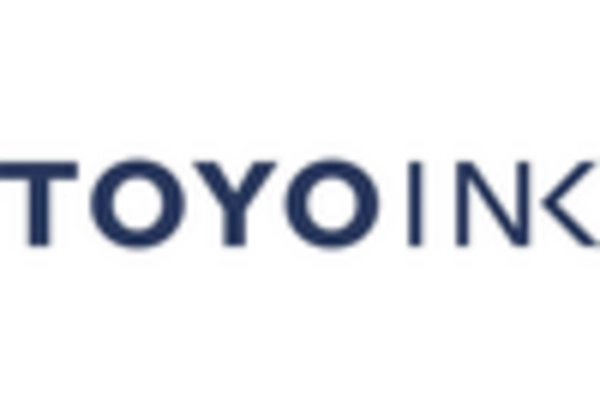Expansion of the Packaging Sector
The packaging sector is a significant driver for the printing inks market in Europe, as the demand for printed packaging solutions continues to grow. With the rise of e-commerce and retail, there is an increasing need for attractive and functional packaging that enhances product visibility. This trend is supported by market data indicating that the packaging segment is expected to grow at a CAGR of 5% over the next few years. Consequently, printing ink manufacturers are focusing on developing specialized inks that cater to the unique requirements of packaging applications, such as durability and color vibrancy. This expansion in the packaging sector is likely to bolster the overall growth of the printing inks market, creating new opportunities for innovation and collaboration.
Regulatory Compliance and Standards
Regulatory compliance and standards are becoming increasingly influential in shaping the printing inks market in Europe. Stricter regulations regarding the use of hazardous substances and environmental impact are prompting manufacturers to reformulate their inks. Compliance with these regulations not only ensures market access but also enhances brand reputation among environmentally conscious consumers. The European Union's REACH regulation, for instance, mandates the registration and evaluation of chemical substances, including inks. This regulatory landscape is likely to drive innovation, as companies seek to develop compliant products that meet both safety and performance standards. Consequently, the focus on regulatory compliance may lead to a more sustainable and responsible printing inks market in Europe.
Rising Demand for Eco-Friendly Inks
The printing inks market in Europe is witnessing a rising demand for eco-friendly inks. This demand is driven by increasing environmental awareness among consumers and regulatory pressures. As sustainability becomes a priority, manufacturers are compelled to develop inks that are less harmful to the environment. Water-based inks and bio-based inks are gaining popularity, as they emit fewer volatile organic compounds (VOCs) and are easier to dispose of. This shift is reflected in market data, which suggests that eco-friendly inks could account for over 30% of the total market share by 2026. The growing emphasis on sustainability is likely to reshape the printing inks market, pushing companies to innovate and adapt to these changing consumer preferences.
Growth of the Digital Printing Segment
The digital printing segment is emerging as a crucial driver for the printing inks market in Europe, as it offers flexibility and efficiency that traditional printing methods cannot match. The increasing adoption of digital printing technologies across various industries, including textiles, labels, and commercial printing, is reshaping the landscape of ink consumption. Market analysis indicates that the digital printing segment could account for nearly 40% of the total printing inks market by 2025. This growth is attributed to the demand for short-run printing and customization, which digital technologies facilitate. As a result, ink manufacturers are likely to invest in developing inks specifically designed for digital applications, further propelling the growth of the printing inks market.
Technological Advancements in Ink Production
The printing inks market in Europe is experiencing a notable transformation due to technological advancements in ink production. Innovations such as the development of high-performance inks and eco-friendly formulations are becoming increasingly prevalent. These advancements not only enhance print quality but also improve the efficiency of the printing process. For instance, the introduction of UV-curable inks has gained traction, allowing for faster drying times and reduced energy consumption. As a result, manufacturers are likely to invest in these technologies, which could lead to a projected growth rate of approximately 4.5% annually in the printing inks market. This trend indicates a shift towards more sustainable and efficient production methods, aligning with the broader industry goals of reducing environmental impact.



















Leave a Comment